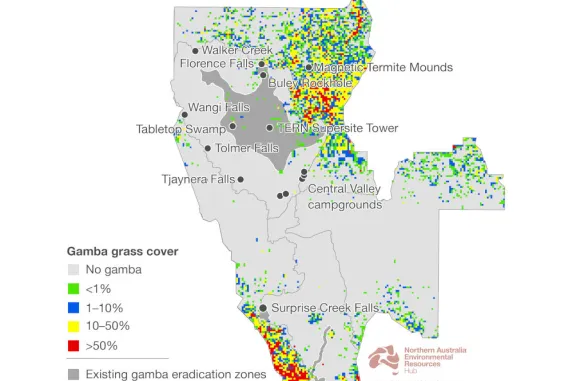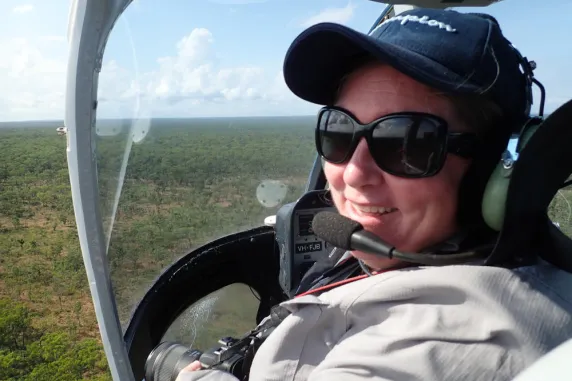RIEL news
RIEL researcher warns of gamba grass threat to Litchfield National Park
New research has warned that almost 30% of Litchfield National Park could be infested with the invasive weed gamba grass within a decade.
Infestations in the national park have spread rapidly and already cover about 30,000 hectares of the 144,000-hectare park.
The research, published in the Journal of Environmental Management, called for urgent action and resources to control the weed, which can pose an extreme fire risk to popular visitor areas.
Charles Darwin University (CDU) ecologist and lead author Dr Natalie Rossiter-Rachor of said Litchfield is an iconic national park in northern Australia.
“It contains significant environmental, cultural and social values. It’s referred to as the ‘jewel in the crown’ of Top End parks,” Dr Rossiter-Rachor said.
“However, our research shows this is all at risk unless a major investment is made in weed control”.
The research, funded by the Australian Government’s National Environmental Science Program and the Northern Territory Government, conducted helicopter surveys of the park in 2014 and again in 2021–22. These surveys showed the invasive weed has spread rapidly since 2014, covering 30,000 hectares of the 144,000-hectare park, including near popular sites such as Florence Falls and Buley Rockhole. It is the largest gamba grass infestation in a national park in Australia.
Tackling gamba grass is identified as a priority in the federal government’s Threatened Species Action Plan. New Australian Government funding of $9.8 million is being directed to strategic gamba grass control in locations where it can be eradicated and contained, such as Kakadu National Park and Arnhem Land.
Given the outcomes of this new research, significant investments are also needed to address catastrophic and established infestations in areas managed by states and territories, such as Litchfield National Park.
Researchers examined three different future management scenarios for gamba grass in the park and modelled the distribution of gamba grass after 10 years of each scenario. Under the do-nothing scenario, gamba grass will continue to rapidly spread in the park, covering more than 42,000 hectares and impacting all popular visitor sites – degrading habitats for threatened species and posing extreme risks for bushfires fuelled by gamba’s large fuel loads.
The second scenario would see gamba grass removed from the Litchfield’s small existing gamba grass eradication zone on Tabletop Range, predicted to cost $825,000 over five years. But under this scenario, sites such as Florence Falls and Tolmer Falls would still become infested and gamba could continue to spread in the rest of the park, covering more than 41,000 hectares of the park over the next decade.
Study co-author Professor Samantha Setterfield from The University of Western Australia said “We propose a new scenario where gamba grass is eradicated over a much larger area of the park to better protect the significant values of the park, predicted to cost $6.6 million over five years. Under this scenario, gamba would be kept away from most major visitor attractions.
This significant investment in intensive gamba grass control and monitoring is needed to protect important habitats and visitor areas in the park.”
Dr Rossiter-Rachor emphasised the need for swift action.
“Gamba is spreading quickly in Litchfield,” Dr Rossiter-Rachor said.
“The longer we wait to fund intensive management action, the more expensive it will become and the more impacts we’ll see to the park’s incredible biodiversity and stunning natural areas.”
This research is published in the Journal of Environmental Management and can be accessed at https://authors.elsevier.com/sd/article/S0301-4797(22)02358-1 .
Factsheet: The gamba grass threat to Litchfield National Park assets (PDF, 910.19 KB)
Contact
Dr Natalie Rossiter-Rachor, Charles Darwin University, natalie.rossiter@cdu.edu.au, 0448 466 551.
Related Articles

Environmental researchers and rangers visit Philippines as part of NT-Philippines exchange
CDU researchers and representative from Dhimurru Aboriginal Corporation completed a valuable exchange with Philippine leaders and rangers in June 2025.
Read more about Environmental researchers and rangers visit Philippines as part of NT-Philippines exchange
Professorial delegation discusses environmental protection and biodiversity in Beijing
Charles Darwin University (CDU) academics were among a high-level Australian delegation that visited the Chinese Academy of Sciences (CAS) last month.
Read more about Professorial delegation discusses environmental protection and biodiversity in Beijing
Rangers and PhD candidate unite at mapping workshop
How can technology support the revival of knowledge, its intergenerational transmission, and the defense of ancestral lands, all while ensuring cultural protocols are upheld?
Read more about Rangers and PhD candidate unite at mapping workshop

